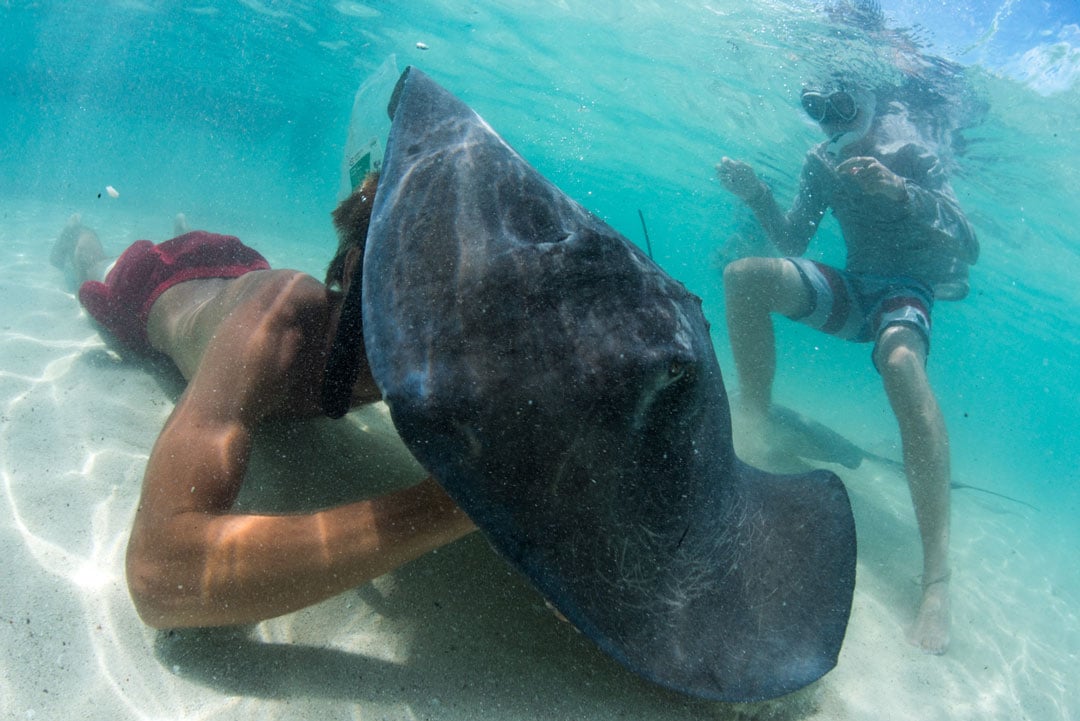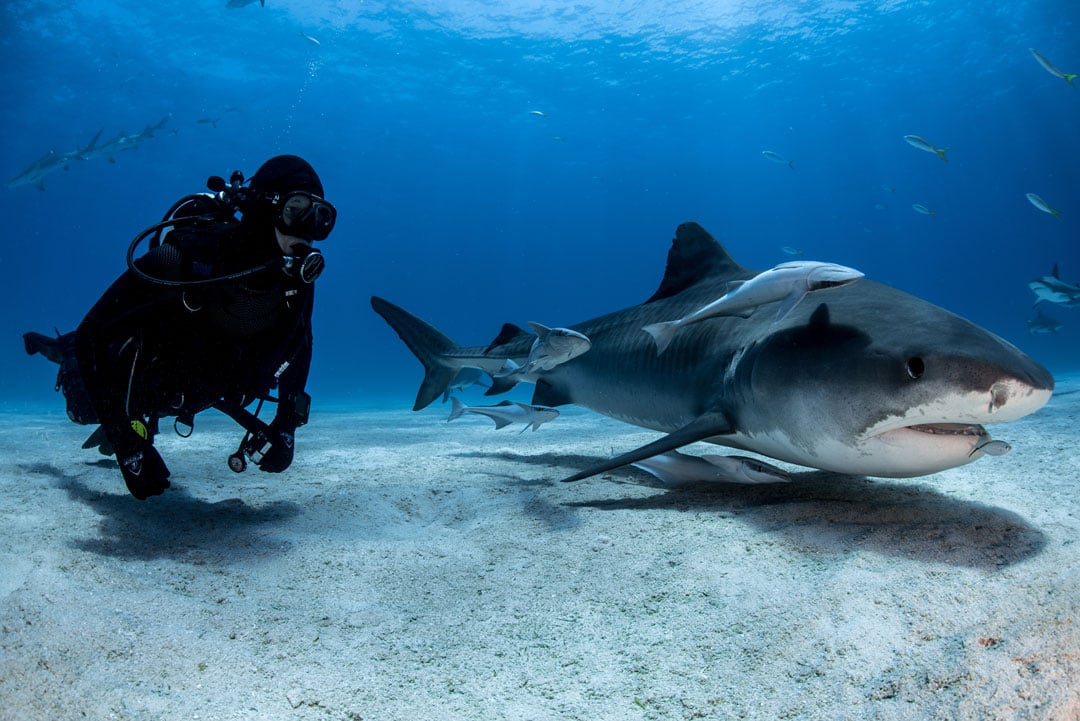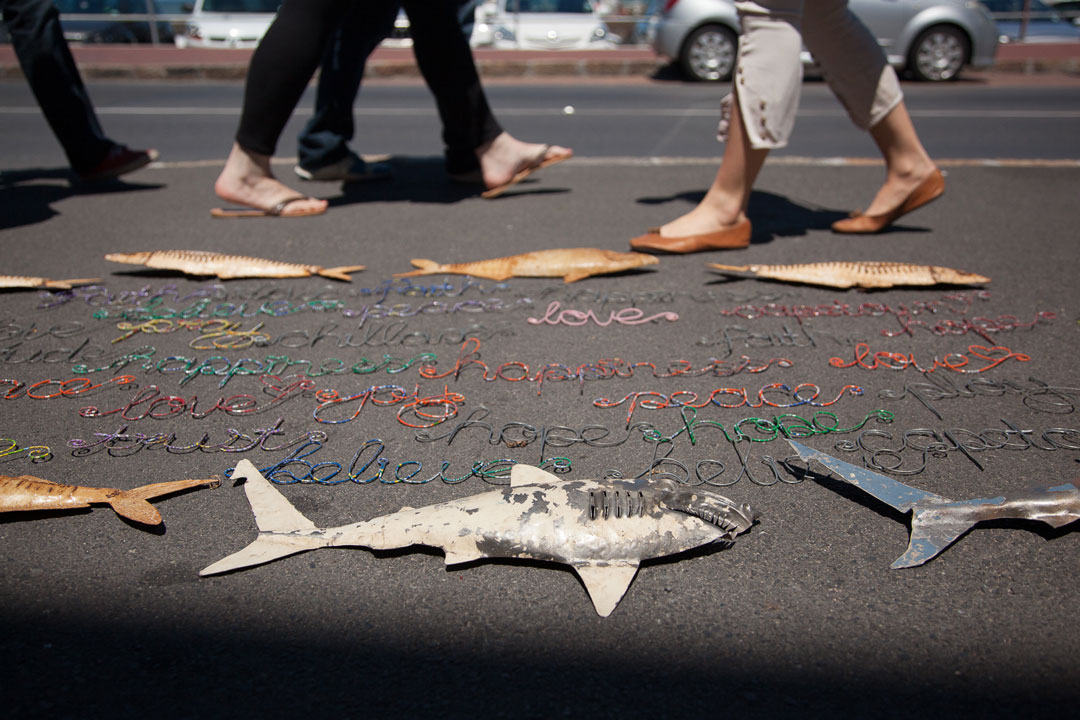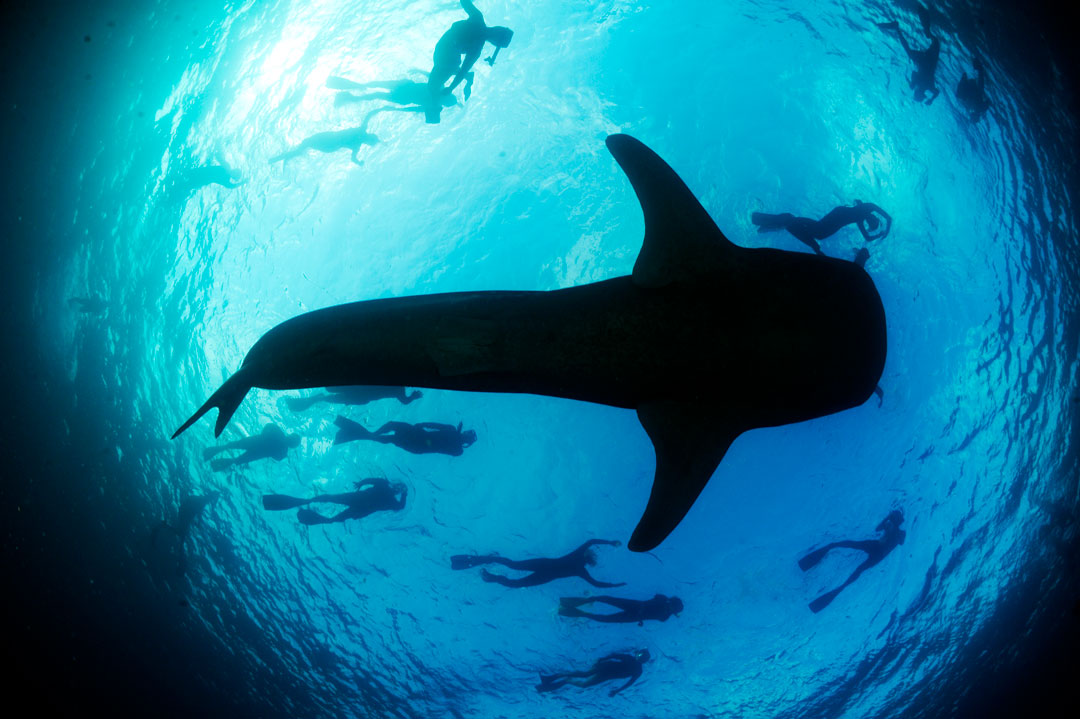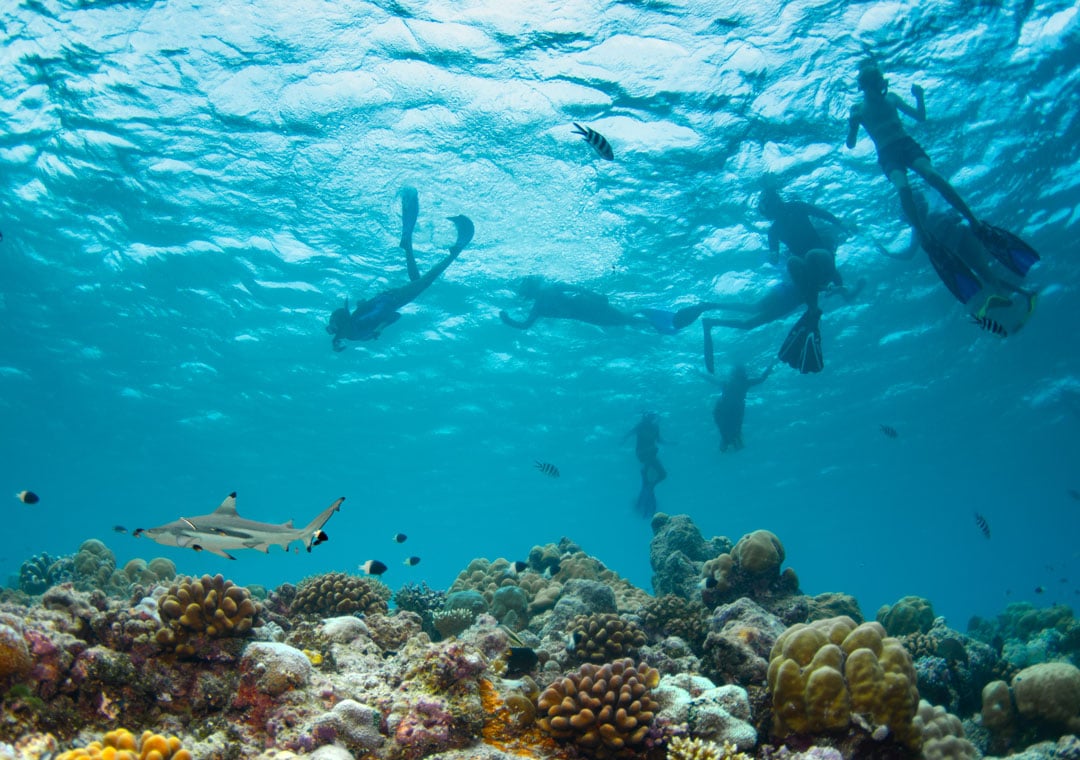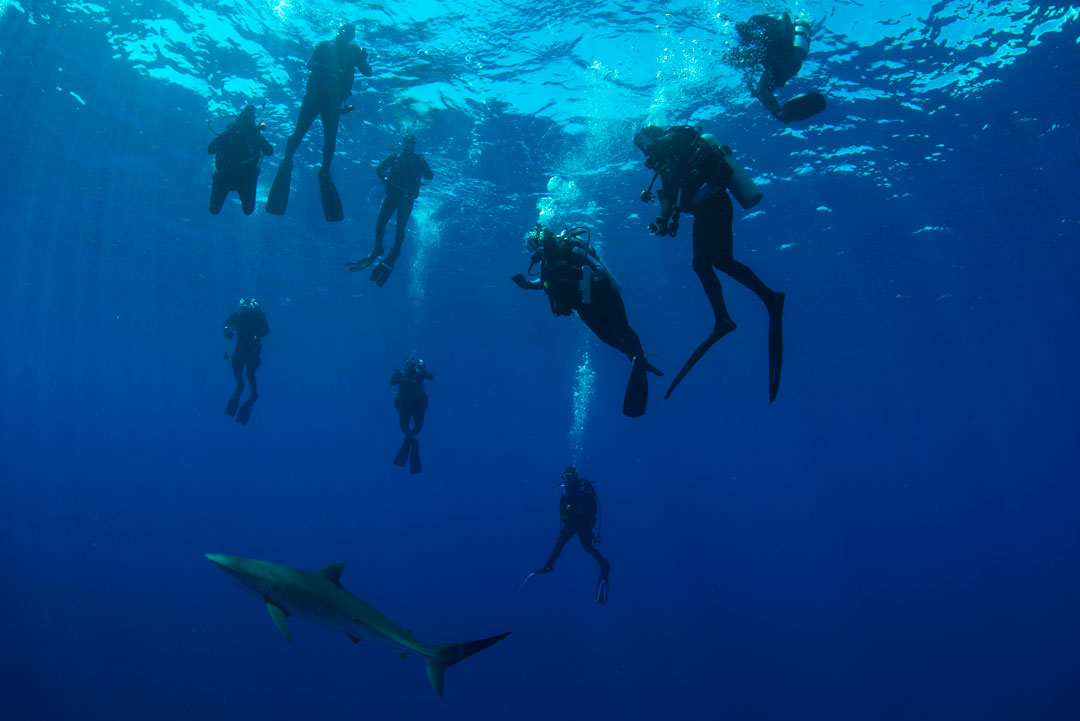Is shark tourism ‘good’, or ‘bad’?
Science Communicator, PhD Conservation ScienceShark tourism is a rapidly growing industry. Opportunities to dive, snorkel and swim alongside some of the ocean’s most iconic inhabitants attract hundreds of thousands of tourists every year – and this figure is only forecasted to rise. Viral videos of unforgettable, but wholly benign, encounters between humans and sharks, coupled with vast improvements in shark education and awareness, have driven more people to experience these enigmatic creatures in the wild. To meet the demand shark tourism operations have sprung up across the world, from the Arctic circle to southern Australia.
But as the appetite for wild encounters increases, the ethics of shark tourism is brought into question. Rapid expansion of the industry has led to unsustainable practices, the negative impacts of which can range from disruption of natural behaviours and movement patterns to shark injuries and even fatalities. Poorly managed tourism can also affect non-target species and the wider marine environment. But, if conducted responsibly, shark tourism can have significant benefits for shark conservation. Having positive experiences with sharks can change perceptions and help spread awareness, steering the narrative away from one of fear, to one of awe and stewardship. It can also provide incentives for local fishers to protect sharks; adding weight to the argument that sharks are ‘more valuable alive than dead’.
So, is shark tourism ‘good’, or ‘bad’? As with most debates around sharks, the ethics of shark tourism is filled with nuance – so let’s take a deep dive into the different ways in which shark tourism is done, the various pros and cons, and what to look out for if you’d like to head off on an adventure of your own.
Is shark cage diving bad for sharks?
Shark cage diving began in South Australia in the 1970s and is one of the most popular and well-known forms of shark tourism to date. But it is also perhaps the most controversial. Concerns mainly surround the practice of chumming or baiting, where food is used to attract the shark and ensure a close encounter for those inside the cage. However, whether this is ‘bad’ for the shark very much depends on how it is done, and the species involved.
What is shark cage diving?
Cage diving involves lowering divers or snorkellers into the water inside a large, protective cage (often made of a strong metal, such as galvanised steel) which is tethered to a boat. Operators will usually base themselves on or near a site where their target species is known to aggregate and use bait or chum to bring the sharks closer to the boat.
Cage diving offers the exhilarating experience of observing sharks in their natural habitat, while minimising the risk of the sharks making contact with you. It is therefore perceived as a ‘safer’ way to interact with some of the larger, predatory shark species, in particular the great white shark (although it should be emphasised that the risk of being bitten by a shark, even outside of a cage, is very minimal). Shark cage diving is also popular due to its accessibility. Scuba qualifications are rarely needed. Although some operators will offer basic scuba equipment, they will also cater for those with little to no experience. As the cages are attached to the side of the boat and mostly suspended at the surface, observers are only partially submerged and can use a mask and snorkel or simply hold their breath to watch the shark as it passes. In fact, you don’t even need to be a strong swimmer. You are stationary for the entire dive, and in most cases can stand or kneel on the bottom of the cage. As a result, cage diving can be a once-in-a-lifetime experience for people who ordinarily wouldn’t have the opportunity to see sharks beneath the surface.
Where can you go shark cage diving?
Cage diving is most commonly associated with white sharks, Carcharodon carcharias (also known as the great white shark) and is therefore popular in parts of the world where they naturally occur: South Australia, New Zealand, Mexico, the U.S.A and South Africa (particularly off the coast of Cape Town and Gansbaai). Operations mainly base themselves near seal colonies, which are a key prey source for white sharks.
Cage diving is also used to encounter other large shark species. You can cage dive with bull sharks, hammerheads and tiger sharks in the Bahamas, sandbar and Galapagos sharks in Hawaii, and bronze whalers (as well as white sharks) off the Western Cape, South Africa.

What is shark baiting?
It is very difficult to see sharks in the wild, especially the larger, pelagic species that cage diving targets. The ocean is a big place, and these sharks travel over enormous distances – sometimes thousands of kilometres. Although cage diving operations base themselves near natural aggregation sites – like seal colonies in the case of white sharks – this doesn’t guarantee a shark will swim close enough to be clearly visible to the divers. Instead, some form of attractant is used to increase the likelihood of a very close – and very exciting – encounter for those inside the cage. These can include scents, baits, decoys (usually a seal-shaped piece of neoprene) and even sound.
‘Baiting’ is common and refers to the use of a whole fish – such as tuna – as a lure. The fish is either thrown overboard or towed behind the boat on a rope or flotation device. In earlier days of the industry, some operators would drag the bait slowly over the cage to bring sharks extremely close to the bars (a practice known as “wrangling”). Or the sharks may have been fed on arrival (sometimes to encourage active behaviours, like breaching and rapid bursts of fast swimming). These practices led to negative interactions, such as sharks becoming entangled in lines or even colliding with the cage. In rare instances, sharks have gotten stuck between the bars and suffered injuries trying to free themselves. A particularly bad incident occurred in 2019, when an adult white shark became stuck in the bars of a cage off Guadalupe Island, Mexico, and later died of its injuries. Scientists have also long debated the effects of baiting on shark behaviour, activity and movements (which we will discuss in more detail later in this article).
In response to these concerns, industry regulations have been tightened and intentionally feeding sharks is now widely prohibited in cage diving, although it is still allowed in other forms of shark and ray tourism (for example, scuba diving with bull sharks in Fiji and snorkelling with stingrays in the Cayman Islands). Instead, baits are removed from the water as soon as the shark in within close proximity. This doesn’t prevent sharks from seizing the bait altogether – they are top predators, after all! – but it does minimise the risk of potentially harmful interactions that threaten the safety of both shark and diver. There are further restrictions on where bait can be placed (not directly on top of the cage, for example), what can be used as bait, size of the cage and the width of the gap between the bars. In fact, cage diving is one of the most regulated and tightly controlled forms of shark tourism in the world.
Outside of cage diving, baiting is used by tourism operations for a host of other species and procedures vary depending on operator and the target species.
What is shark chumming?
Similar to bait, chum is used to attract sharks to ensure reliable, close encounters while cage diving. However, ‘chum’ refers specifically to a specially designed, man-made substance; usually a mixture of small chunks of fish, fish oil and fish blood, put through a mincer. This is dumped overboard and used to create an enticing scent trail. The key here is to make as whiffy a concoction as possible, so operators will use a combination of strong-smelling, oily fish, like mackerel, anchovies, sardines and squid.
Both baiting and chumming are common practice and are regularly used in research to help scientists observe sharks in their natural habitat and carry out important procedures, like tagging.
Does baiting cause sharks to associate humans with food?
A widespread concern around baiting and chumming for sharks is that it will lead to the sharks to associate people with food, and increase the likelihood of negative interactions in other areas. Many cage diving and other tourism companies operate out of nearby coastal towns, and residents have been vocal about their worries that baiting may heighten the risk of sharks approaching water-goers. Whether it does or not is hard to know for certain. The number of shark bite incidents in general remains low, and there are a number of ecological, environmental and behavioural factors that culminate in a bite. It would be very difficult to make a definitive link between an incident and baiting or chumming by a tourism operator. Overall, there is very little empirical evidence to support the theory that baiting carried out by cage diving operations leads to more shark bite incidents in neighbouring towns.
There is however some evidence to suggest that hand-feeding can lead to behavioural changes and more frequent interactions between tourists and sharks directly at the dive site – although the exact nature of these interactions depends on the species and human behaviour. For example, fed southern stingrays Dasyatis americana have been observed becoming more inquisitive, and even ‘pushy’, towards tourists with food. Similarly, individual silky sharks provided with food rewards have been described as acting ‘more boldy’ around divers. Hand-feeding may also increase the risk of a bite at the dive site, especially during breeding season when some species may be displaying more naturally aggressive behaviours. Hand-feeding, or intentional provisioning, should therefore be tightly managed and regulated – as it already is in cage-diving.

Is baiting bad for sharks?
The potential side-effects of baiting and chumming on their behaviour and ecology have long been debated in the scientific and conservation community. Research is limited, and the results vary widely depending on the procedure and species. Impacts can vary from negligible to substantial; in some cases, sharks have foregone their natural foraging habits, movement patterns, and even migratory routes. The long-lasting effects remain largely unknown, but there are concerns for the overall health and survival of some species if practices are not carefully managed.
With respect to cage diving specifically, there is some scientific evidence that suggests sharks are altering their behaviour in sites where such operations occur, at least in the short-term. For example, at the Neptune Islands in South Australia, white sharks, a highly migratory species, have been observed hanging around for longer periods at sites where shark cage diving operations were present. There is also evidence that white sharks swim at shallower depths, dive less, and engage in more high energy activity (such as more frequent bursts of speed) around cage diving operations. However, as there is no food reward (directly feeding sharks is prohibited in cage diving), most sharks become gradually more disinterested over time and eventually stop returning to the boat. And, research has found little detectable impact of tourism on the long-term diet, body condition or migratory patterns of white sharks . The likelihood is that, as white sharks are a highly mobile species, their interactions with tourism operations are relatively infrequent and they still must utilise a variety of prey sources.
The effects of baiting outside of cage diving, however, are more mixed, depending on the species in question. For example, similarly minor effects have been found for bull sharks Carcharhinus leucas in Fiji, who have been provisioned during recreational dives. However, other species have been observed changing their behaviour, movements and daily activity patterns in response to baiting for tourism. These include tiger sharks in the Bahamas, whale sharks in the Philippines and sicklefin lemon sharks in French Polynesia. Perhaps one of the starkest examples is that of southern stingrays in the Cayman Islands, where supplemental feeding by dive operators has been occurring since the 1980s. Stingrays now aggregate in the same two dive sites almost daily, a significant departure from their usual distribution and daily movement patterns.
The key question is whether these changes are having long-lasting impacts on the health and fitness of the animal. Again, this is a difficult question to answer and the science isn’t conclusive. Research has looked into the amount of energy expended by these new behaviours and increased activity levels, and there is a concern that the bait provided isn’t enough to replace the energy lost – especially in the case of whale sharks. This could have implications for the animal’s overall condition. However, other studies have suggested that, where high-calorie bait is used, the shark’s energetic requirements are met and provisioning can even have a positive effect on the animal’s health. This has been found in studies of bull sharks in Fiji and Caribbean reef sharks. Whether baiting is ‘bad’ therefore depends on a number of factors, including the type of bait used, the length of interaction, and the species in question. However, operators should follow strict codes of conduct based on the best available scientific evidence and guidance to minimise the potential negative impacts of baiting.
Is shark cage diving ‘bad’ for sharks?
The answer to whether cage diving is ethical depends very much on how it is done. Operators should make their procedures clear and follow strict codes of conduct to protect both sharks and people, which include never directly feeding the animal (a practice that is prohibited in many parts of the world). Sharks should never be provoked or harassed, and energetically costly behaviours like breaching or biting the cage should never be encouraged. And operators should only remain in the proximity of the sharks for a limited amount of time (most guidelines state 90 minutes). But, when done right, cage diving can be a tool to support shark science and conservation – like many other forms of shark tourism.
Can tourism be harmful to sharks?
Like any industry, tourism has the potential to negatively impact sharks – and the wider marine environment – if it is unregulated and poorly managed. One of the prime examples of this is whale shark tourism. Whale sharks are the biggest fish in the ocean, reaching over 40 feet in length, but they are gentle giants. As filter feeders, whale sharks eat a diet of zooplankton (including tiny crustaceans and invertebrates) and are not harmful to humans. Their enormous size and benign nature makes them a major tourist attraction, and many people travel across the world to free-swim alongside them. Unlike cage diving, whale shark tourism has minimal management and where regulations exist, compliance is very low in some of the most popular sites (like Oslob, in the Philipenes). At these sites, the sheer number of boats and people has had detrimental impacts on the animals. Individual whale sharks at popular tourism sites show evidence of repeated injury, such as scarring, lacerations and even amputations as a result of colliding with boats and propellers. The stress of such injuries on the animal is unknown, but there are suggestions that whale sharks change their behaviour following an injury, remaining at the site for much longer than normal (which places them at higher risk of further boat strikes). Furthermore, unregulated feeding of whale sharks seems to impact their habitat use and movement patterns. In Oslob, sharks were found to spend much more time at the surface and to actively seek out operators. These behavioural changes could further endanger the sharks, causing them to expend unnecessary energy and potentially collide with boats, resulting in injury.
How can shark tourism benefit sharks?
If well managed and conducted responsibly, shark tourism can significantly benefit shark conservation.
Changing public perception and spreading awareness
Recent studies have shown that experiences of cage diving can counteract damaging narratives about sharks. One study, published in 2022, surveyed tourists participating in white shark cage diving out of Gansbaai, South Africa, before and after the dive. It found that 75% of participants considered white sharks to be ‘less aggressive’ following their dive, compared to just 45% pre-dive. And over 10% more participants rejected the idea that sharks were just ‘mindless killers’ after seeing the animals for themselves. Another study, this time looking at cage diving operations in South Australia, found that participants were more pro-conservation after the tour and would choose sustainable seafood options, donate money to relevant charities, talk to friends and family positively about sharks and even write to local government to ask for more protective measures for sharks.
Supporting local communities
Another argument in favour of shark tourism is the potential to boost global and local economies. It is estimated that shark tourism generates more than $314-million per year globally and supports over 10,000 jobs. In the Maldives alone, the annual revenue from manta ray watching was estimated at $8.1-million in 2013. In Nosy Be, Madagascar, whale shark tourism across the three-month season in 2019 was worth an estimated $1.5-million. And shark and ray tourism accounts for 7% of the total revenue from marine tourism in Indonesia – a whopping $22-million in 2017.
It is hoped that the money this tourism generates can help to alleviate the problem of overfishing by providing alternative livelihood options and driving local support for sharks (as there will be more incentive to keep sharks alive and thriving, and out of a fishing net). However, an important caveat is how much of this revenue is kept within the local community – and whether the benefits actually reach fishers. A study published in 2020 found that the revenue generated from shark and ray tourism in Indonesia was not trickling down into the local community, and shark fishers in particular were missing out on the benefits. This reduced the incentive for fishers to conserve sharks.
Given that overfishing is the primary threat to sharks and rays globally, engaging with fishers and ensuring that they are provided with an adequate incentive to protect sharks is vital. This is something that Save Our Seas Foundation project leader Hollie Booth is currently investigating in Indonesia, with her project ‘Solutions for Shark Fisheries in a Surfer’s Paradise’. Working closely with both fishing and tourism industries, Hollie and her team have developed an incentive-based scheme where revenue generated from Indonesia’s thriving tourism trade has been used to compensate fishers for releasing critically endangered wedgefish and hammerhead sharks. Because fishers receive the same amount of payment that they would receive from landing the animal, they do not suffer an economic cost. Overall, the scheme has been viewed positively by the local community.
Supporting scientific research
Shark tourism can be used to support research and conservation efforts, and in many cases around the world tourism operations have contributed substantially to our understanding of shark behaviour, movements and threats. Dedicated research vessels are costly, so collaborating with tourism operators is often a more viable option for scientists. Operators can provide scientists with valuable boat time and access to hard-to-reach areas, offering rare opportunities to observe and collect data from sharks in the wild. And, as operators are spending considerable time and effort locating and observing sharks, they often have unique insight and knowledge that can benefit science; they know the best places to find aggregations, for example, or witness previously unrecorded behaviour. A good instance of the latter is of basking sharks, a large, filter-feeding species with a life shrouded in mystery. Video footage and underwater observations captured from tourist vessels have been used as data to classify behaviour that is new to science, like the impressive courtship ‘torus’ circling, close-following and breaching.
Tourism can also offer an opportunity for guests to get involved with research, via citizen science. Some operators offer dedicated research expeditions, partnering with scientific institutions to build field skills and participate in data collection. Divers, swimmers and snorkellers can also collect valuable information during their encounters, especially given the technology many of us have access to. One of the most common forms of citizen science in shark and ray tourism is photo ID. Divers, snorkellers and observers can submit their photographs and video footage to various catalogues, as many species have unique physical traits that can be used to identify individuals. White sharks can be identified from the unique features and markings of their dorsal fin, and photographs clearly showing the fin can be uploaded to databases like that of the Shark Research Unit in Mossel Bay, South Africa. And manta rays can be identified from the spot patterns on their bellies, which are unique to each individual. ID The Manta, an initiative set up by the Manta Trust, receives more than 5,000 photographs from divers a year and has been able to identify over 10,000 individual reef and oceanic manta rays!
Different types of shark and ray tourism
- Cage diving
Cage diving involves being lowered into the water in a protective cage and using snorkelling masks or scuba equipment to observe sharks as they pass. The cage prevents the shark from making contact with you. It is most commonly used for larger species, like white sharks, bull sharks and tiger sharks.
- Scuba diving
There are many opportunities to go on guided scuba dives with different shark and ray species. Operators may travel to a shark and ray hotspot, where the species is known to aggregate (such as feeding grounds or cleaning stations), or there are baited dives. In the latter, the guide may carry a bait to attract sharks to the site. In other instances the divers will sit on the sea floor while the shark is fed in the centre. These experiences require a scuba qualification and which level of qualification is needed depends on the depth, location and conditions of the dive, as well as the species involved.
- Snorkelling
Snorkel experiences are a more accessible way to see sharks, as they don’t necessarily require a scuba diving qualification. Snorkelling involves swimming mainly at the surface, using a mask to see underwater and a snorkel to breathe while you are facing down (you can also duck dive, to see further under the surface). This is a particularly good way to experience species that feed in shallower waters, such as basking sharks, whale sharks and many ray and skate species.
- Watching
You don’t even need to get wet to see sharks! Many operators offer opportunities for ‘watchers’ or ‘observers’ to view sharks from the deck of the boat as they swim close to the surface. Some sharks, like white sharks, breach – jump clear of the water – which is a very special thing to witness from the boat!
- Research expeditions
You can experience sharks and contribute to science at the same time by joining dedicated research expeditions, which are led by tourism operators partnering with researchers and research institutes or by the institutes themselves. You are given an opportunity to collect data and your fee helps scientists carry out their work. Because these experiences involve hands-on work, they are often a little more intense than your average holiday trip, but they can be incredibly rewarding.
How to be a responsible shark tourist/How to choose a responsible shark tourism operator
- Do your research
Before deciding on your adventure, it’s worth spending some time researching species, locations and operators. There is already a lot of information about which locations to avoid, what times of year are best to go, and who to go with. Take your time and find the right one for you.
When it comes to shark and ray tourism, three core factors should guide your search: the welfare and safety of the sharks; your own safety; and the impact on the wider marine environment. Does your chosen location have a problem with overcrowding? Is there evidence of bad practice, such as harassment of the shark or intentional feeding? Does your operator work with marine scientists? How are its guides trained and what safety procedures do they have in place? How many people does your operator put in the water at any one time? Larger group sizes are not only potentially stressful for the sharks, but they could also impact your safety, as that means more people for the guide to look after. These are the kinds of questions to be asking.
Social media, online forums and websites like TripAdvisor can be helpful here, as you can see and read other people’s lived experience and ratings of certain locations and operators.
- Look for the code of conduct
Operators should follow a strict code of conduct and clearly state their procedures on their websites (and in any communication). This should also be communicated clearly to you before your trip and enforced by the guides or operator. Conduct will vary depending on the species and the type of experience (for example, rules will be different for snorkelling with a whale shark versus cage diving with white sharks), but in general they should be informed by the best available science and guidance, adhere to local laws, protect your safety and well-being and, most importantly, minimise stress and disturbance to the animal. Good examples of this are the Manta Trust’s Code of Conduct for swimming with manta rays (https://swimwithmantas.org/) or the Code of Conduct for encountering basking sharks, developed by the Irish Basking Shark Group (https://www.baskingshark.ie/downloads).
Good examples from Manta trust on how to swim with manta rays:





- Is the operator accredited?
As well as a code of conduct, there are many accreditation schemes that promote responsible wildlife watching. Operators can take a course from a licensed organisation that will train them in ways to minimise their impact on sharks and other marine wildlife while operating a vessel or guiding in-water experiences. These vary based on location. Some examples are the WiSe scheme in the UK or the Marine Tourism Accreditation by the Tourism Council of Western Australia.
Look out for operators that are accredited in this way – they will often state this on their websites. Alternatively, the scheme often lists accredited operators on its own website.
- Choose an experience with purpose
An operator’s website can tell you a lot about it. Is it partnering with scientific institutions or conservation organisations? Does it have information on its website about the threats to sharks and rays, and their conservation? Does it have a focus on education, awareness and conservation? Some operators will donate some of their proceeds to conservation efforts or state that they are collecting data for research purposes.
- Listen to your guide
So, you’ve picked a responsible operator and you’re on your big adventure. Now it’s over to you. Your guides will have your, and the shark’s, best interests in mind. Follow their instructions carefully and respect their guidance. Never touch, chase after or harass the shark. Be aware of your surroundings and make sure that you dive and swim within your experience and fitness levels. All of this will help you to have the best experience possible, while looking after the sharks and rays that you’ve come to see.
References
Abrantes, K.G., Brunnschweiler, J.M. and Barnett, A. 2018. You are what you eat: Examining the effects of provisioning tourism on shark diets. Biological conservation, 224, pp.300-308.
Allen, H.L., Stewart, B.D., McClean, C.J., Hancock, J. and Rees, R. 2021. Anthropogenic injury and site fidelity in Maldivian whale sharks (Rhincodon typus). Aquatic Conservation: Marine and Freshwater Ecosystems, 31(6), pp.1429-1442.
Apps, K., Dimmock, K. and Huveneers, C. 2018. Turning wildlife experiences into conservation action: Can white shark cage-dive tourism influence conservation behaviour? Marine Policy, 88, pp.108-115.
Araujo, G., Labaja, J., Snow, S., Huveneers, C. and Ponzo, A. 2020. Changes in diving behaviour and habitat use of provisioned whale sharks: implications for management. Scientific Reports, 10(1), pp.16951.
Beqa Adventure Divers. The Fiji shark dive. https://www.fijisharkdive.com/the-fiji-shark-dive/
Booth, H., Ramdlan, M.S., Hafizh, A., Wongsopatty, K., Mourato, S., Pienkowski, T., Adrinato, L. and Milner-Gulland, E.J. 2023. Designing locally-appropriate conservation incentives for small-scale fishers. Biological Conservation, 277, pp.109821.
Bradford, R., Patterson, T.A., Rogers, P.J., McAuley, R., Mountford, S., Huveneers, C., Robbins, R., Fox, A. and Bruce, B.D. 2020. Evidence of diverse movement strategies and habitat use by white sharks, Carcharodon carcharias, off southern Australia. Marine Biology, 167, pp.1-12.
Brunnschweiler J.M, Payne N. L., and Barnett A. 2018. Hand feeding can periodically fuel a major portion of bull shark energy requirements at a provisioning site in Fiji. Animal Conservation 21, pp.31–35.
Cisneros-Montemayor, A.M., Barnes-Mauthe, M., Al-Abdulrazzak, D., Navarro-Holm, E. and Sumaila, U.R., 2013. Global economic value of shark ecotourism: implications for conservation. Oryx, 47(3), pp.381-388.
Clua, E., Buray, N., Legendre, P., Mourier, J. and Planes, S. 2010. Behavioural response of sicklefin lemon sharks Negaprion acutidens to underwater feeding for ecotourism purposes. Marine Ecology Progress Series, 414, pp.257-266.
Corcoran, M.J., Wetherbee, B.M., Shivji, M.S., Potenski, M.D., Chapman, D.D. and Harvey, G.M. 2013. Supplemental feeding for ecotourism reverses diel activity and alters movement patterns and spatial distribution of the southern stingray, Dasyatis americana. PLoS One, 8(3), pp.e59235.
Florida Museum. Shark Attack Compared to Other Risks. https://www.floridamuseum.ufl.edu/shark-attacks/odds/.
Florida Museum. Yearly shark attack summary. https://www.floridamuseum.ufl.edu/shark-attacks/yearly-worldwide-summary/.
Gore M., Abels L., Wasik S., Saddler L., and Ormond R. 2018. Are close-following and breaching behaviours by basking sharks at aggregation sites related to courtship? Journal of the Marine Biological Association of the United Kingdom, 99, pp. 681 - 693.
Hoenicka, M.A.K., Andreotti, S., Carvajal-Chitty, H. and Matthee, C.A., 2022. The role of controlled human-animal interactions in changing the negative perceptions towards white sharks, in a sample of White Shark cage diving tours participants. Marine Policy, 143, pp.105130.
Huveneers, C., Rogers, P.J., Beckmann, C., Semmens, J.M., Bruce, B.D. and Seuront, L. 2013. The effects of cage-diving activities on the fine-scale swimming behaviour and space use of white sharks. Marine Biology, 160, pp.2863-2875.
Jacoby, D.M., Fairbairn, B.S., Frazier, B.S., Gallagher, A.J., Heithaus, M.R., Cooke, S.J. and Hammerschlag, N. 2021. Social network analysis reveals the subtle impacts of tourist provisioning on the social behavior of a generalist marine apex predator. Frontiers in Marine Science, 8, pp.665726.
Legaspi, C., Miranda, J., Labaja, J., Snow, S., Ponzo, A. and Araujo, G. 2020. In-water observations highlight the effects of provisioning on whale shark behaviour at the world's largest whale shark tourism destination. Royal Society Open Science, 7(12), pp.200392.
Maillaud, C. and Van Grevelynghe, G. 2005. Shark attacks and bites in French Polynesia. European Journal of Emergencies , 18 (1), pp.37-41.
Maljković A, Côté I.M. 2011. Effects of tourism-related provisioning on the trophic signatures and movement patterns of an apex predator, the Caribbean reef shark. Biological Conservation, 144, pp.859-865.
Manta Trust. ID the Manta. https://www.mantatrust.org/idthemanta
Meyer, L., Pethybridge, H., Beckmann, C., Bruce, B. and Huveneers, C. 2019. The impact of wildlife tourism on the foraging ecology and nutritional condition of an apex predator. Tourism Management, 75, pp.206-215.
Mustika, P.L.K., Ichsan, M. and Booth, H. 2020. The economic value of shark and ray tourism in Indonesia and its role in delivering conservation outcomes. Frontiers in Marine Science, 7, pp.261.
New Zealand Department of Conservation. 2015. Commercial Great White Shark Cage Diving New Zealand Code of Practice. www.doc.govt.nz/Documents/conservation/marine-and-coastal/shark-cage-diving/code-of-practice.pdf
Penketh, L., Schleimer, A., Labaja, J., Snow, S., Ponzo, A. and Araujo, G. 2021. Scarring patterns of whale sharks, Rhincodon typus, at a provisioning site in the Philippines. Aquatic Conservation: Marine and Freshwater Ecosystems, 31(1), pp.99-111.
Semeniuk, C.A. and Rothley, K.D. 2008. Costs of group-living for a normally solitary forager: effects of provisioning tourism on southern stingrays Dasyatis americana. Marine Ecology Progress Series, 357, pp.271-282.
Shark Research Unit. South African great white shark identification database. https://shark-research.com/south-african-great-white-shark-photographic-identification-database/.
Sims, D. W. 2008. Sieving a living: A review of the biology, ecology and conservation status of the plankton-feeding basking shark Cetorhinus maximus. Advances in Marine Biology, 54, pp.171–220.
The Wise Scheme. The UK National training scheme for minimising disturbances to marine wildlife. https://www.wisescheme.org
Tourism Council. Marine Tourism Accreditation. https://tourismcouncilwa.com.au/programs-accreditation/marine-tourism-accreditation
Wetherbee B.M. Movement patterns and habitat use of southern stingrays (Dasyatis Americana) at a tourist site in the Cayman Islands. https://web.uri.edu/wetherbee/movement-patterns-and-habitat-use-of-southern-stingrays-dasyatis-americana-at-a-tourist-site-in-the-cayman-islands/.
